This article needs additional citations for verification .(November 2010) |

Robert Alwin Schlumberger, Edler von Goldeck (12 September 1814 - 13 July 1879) was an entrepreneur and the first producer of sparkling wine (German: Sekt) in Austria.
This article needs additional citations for verification .(November 2010) |

Robert Alwin Schlumberger, Edler von Goldeck (12 September 1814 - 13 July 1879) was an entrepreneur and the first producer of sparkling wine (German: Sekt) in Austria.
Schlumberger was born in Stuttgart in the German Kingdom of Württemberg. Upon the early death of his father, he began a commercial apprenticeship. As director of Ruinart, one of the leading champagne houses in Reims, France, he was experienced with the méthode champenoise . In 1841, on a boat trip he met his future wife Sophie Kirchner from Vienna, the daughter of a wealthy factory owner. He had the idea to produce champagne-like wine (Schaumwein) in Austria using the French method but Austrian grapes.
In 1842, Schlumberger founded his company renting several vineyards in Vöslau, a small Lower Austrian town south of Vienna situated in the present-day Thermenregion wine-growing area of the eastern Vienna Woods. His alliance which Sophie Kirchner, whom he married in the following year, helped him finance his business venture. Schlumberger presented his first sparkling wine in 1846 under the name Vöslauer weißer Schaumwein (White sparkling wine of Vöslau), from 1859 under Vöslauer Goldeck, the first protected wine trademark in Austria. It was produced from red Blauer Portugieser grapes growing in the Goldeck vineyards in Vöslau, which Schlumberger bought in 1843, and the sparkling wine was an immediate success. [1]
Schlumberger wines were on board of the SMS Novara on its around-the-world mission 1857-1859. The company opened branch stores in Berlin and after the 1862 International Exhibition also in London, where the wine was sold under the brand name "Vöslauer Sparkling". Robert Schlumberger also served as Vöslau mayor from 1864 to 1870. In 1878, one year before his death, he was ennobled by Emperor Franz Joseph I of Austria as "Edler von Goldeck". He died in Vöslau, aged 64.

Schlumberger's son and heir Otto received the title of a K.u.k. Hoflieferant in 1895. The company survived the dissolution of the Austro-Hungarian Monarchy in 1918 and up to today, Schlumberger Wein- und Sektkellerei GmbH with its seat at Vienna-Döbling is one of the leading producers of sparkling wine in Austria. In 1973, it was taken over by the German Underberg company.
Bjørnstjerne Bjørnson (1832–1910) in a letter to his daughter Bergliot from Schwaz in Tyrol, 29 May 1894:
We drank Vöslauer Schaumwein, and maybe it was time place and mood that made a difference, but the best Champagne does not suit me like this one. [2]
Vöslauer wine is also mentioned by John Galsworthy (1867–1933) in his 1926 play Escape as well as in the 1957 volume of novellas Fin de siècle by Paul Morand (1888–1976).

Sparkling wine is a wine with significant levels of carbon dioxide in it, making it fizzy. While it is common to refer to this as champagne, European Union countries legally reserve that word for products exclusively produced in the Champagne region of France. Sparkling wine is usually either white or rosé, but there are examples of red sparkling wines such as the Italian Brachetto, Bonarda and Lambrusco, and the Australian sparkling Shiraz. The sweetness of sparkling wine can range from very dry brut styles to sweeter doux varieties.

Pinot noir, also known as Pinot nero, is a red-wine grape variety of the species Vitis vinifera. The name also refers to wines created predominantly from Pinot noir grapes. The name is derived from the French words for pine and black. The word pine alludes to the grape variety having tightly clustered, pinecone—shaped bunches of fruit.

The Zweigelt, also known as Rotburger, is an Austrian hybrid grape variety created in 1922 by Friedrich Zweigelt (1888–1964), who later became Director of the Federal Institute and Experimental Station of Viticulture, Fruit Production and Horticulture (1938–1945). Zweigelt is a crossing between the St. Laurent and Blaufränkisch grape varieties.

Blaufränkisch is a dark-skinned variety of grape used for red wine. Blaufränkisch, which is a late-ripening variety, produces red wines which are typically rich in tannin and may exhibit a pronounced spicy character.

A rosé is a type of wine that incorporates some of the color from the grape skins, but not enough to qualify it as a red wine. It may be the oldest known type of wine, as it is the most straightforward to make with the skin contact method. The pink color can range from a pale "onionskin" orange to a vivid near-purple, depending on the grape varieties used and winemaking techniques. Usually, the wine is labelled rosé in French, Portuguese, and English-speaking countries, rosado in Spanish, or rosato in Italian.
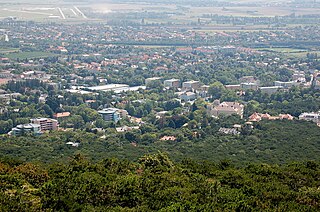
Bad Vöslau is a spa town and municipality in the state of Lower Austria. It is also known as the cradle of the Austrian red wine cultivation. The population, as of 2022, is 12,424.

French wine is produced all throughout France, in quantities between 50 and 60 million hectolitres per year, or 7–8 billion bottles. France is one of the largest wine producers in the world, along with Italian, Spanish, and American wine-producing regions. French wine traces its history to the 6th century BCE, with many of France's regions dating their wine-making history to Roman times. The wines produced range from expensive wines sold internationally to modest wines usually only seen within France such as the Margnat wines of the post-war period.

The wine industry of Ukraine is well-established with long traditions. Several brands of wine from Ukraine are exported to bordering countries, the European Union, and North America. Amid the 2022 Russian invasion of Ukraine Ukrainian winemakers continued to work and produce wine.
The glossary of wine terms lists the definitions of many general terms used within the wine industry. For terms specific to viticulture, winemaking, grape varieties, and wine tasting, see the topic specific list in the "See also" section below.
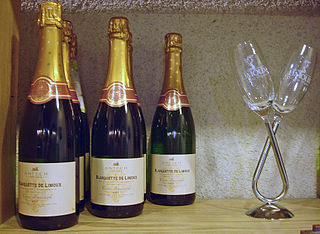
Limoux wine is produced around the city of Limoux in Languedoc in southwestern France. Limoux wine is produced under four Appellation d'origine contrôlée (AOC) designations: Blanquette de Limoux, Blanquette méthode ancestrale, Crémant de Limoux and Limoux, the first three of which are sparkling wines and dominate the production around Limoux. The main grape of the region is the Mauzac, locally known as Blanquette, followed by Chardonnay and Chenin blanc. In 2005, the Limoux AOC was created to include red wine production consisting of mostly Merlot. Wine historians believe that the world's first sparkling wine was produced in this region in 1531, by the monks at the abbey in Saint-Hilaire.
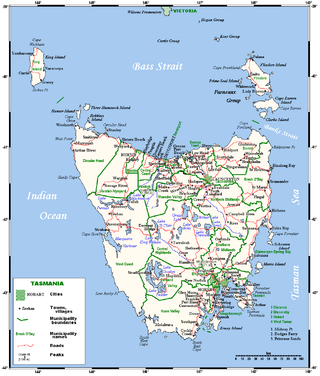
Tasmanian wine is wine produced in the Australian state of Tasmania. Located at a more southerly latitude than the rest of Australia's wine regions, Tasmania has a cooler climate and the potential to make distinctly different wines than in the rest of the country. The area grows primarily Pinot noir, Chardonnay and Sauvignon blanc, with some smaller plantings of Riesling, Pinot gris and Cabernet Sauvignon. Global warming has had positive effects on the Tasmanian wine industry, allowing most of the grapes in the past few vintages to ripen fully and produce more vibrant wine.

The Loire Valley wine region includes the French wine regions situated along the river Loire from the Muscadet region near the city of Nantes on the Atlantic coast to the region of Sancerre and Pouilly-Fumé just southeast of the city of Orléans in north central France. In between are the regions of Anjou wine, Saumur, Bourgueil, Chinon, and Vouvray. The Loire Valley itself follows the river through the Loire department to the river's origins in the Cévennes but the majority of the wine production takes place in the regions noted above. The area includes 87 appellations under the Appellation d'origine contrôlée (AOC) and Indication Géographique Protégée (IGP) systems. While the majority of production is white wine from the Chenin blanc, Sauvignon blanc and Melon de Bourgogne grapes, there are red wines made from Cabernet franc. In addition to still wines, rosé, sparkling and dessert wines are also produced. With Crémant production throughout the Loire, it is the second largest sparkling wine producer in France after Champagne. Among these different wine styles, Loire wines tend to exhibit characteristic fruitiness with fresh, crisp flavors-especially in their youth. The Loire Valley has a long history of winemaking dating back to the 1st century. In the High Middle Ages, the wines of the Loire Valley were the most esteemed wines in England and France, even more prized than those from Bordeaux.
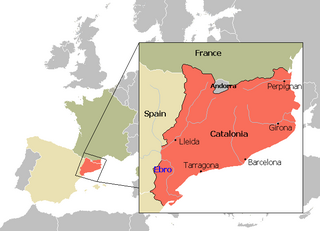
Catalan wines are those that are produced in the wine regions of Catalonia. Occasionally, the appellation is applied to some French wine made in the Catalan region of Roussillon and neighboring areas, also known as Northern Catalonia or the Pays catalans. The city of Barcelona is the capital of Catalonia and despite not being in a wine region, it is the focal point of the Catalan wine industry: a primary consumer market, its port provides export functions and a source of financial resources and investment. The Penedès is the largest wine-making region in Catalonia.
Dawnine Sample Dyer is an American winemaker and entrepreneur who pioneered the use of champagne-making methods in California's fledgling sparkling wine industry in the 1970s.

California wine production has a rich viticulture history since 1680 when Spanish Jesuit missionaries planted Vitis vinifera vines native to the Mediterranean region in their established missions to produce wine for religious services. In the 1770s, Spanish missionaries continued the practice under the direction of the Father Junípero Serra who planted California's first vineyard at Mission San Juan Capistrano.

The history of Champagne began when the Romans planted vineyards in this region of northeast France in the 5th century, or possibly earlier. Over centuries, Champagne evolved from being a pale, pinkish still wine to a sparkling wine. When Hugh Capet was crowned King of France in 987 at the cathedral of Reims, he started a tradition that brought successive monarchs to the region—with the local wine being on prominent display at the coronation banquets. The early wine of the Champagne region was a pale, pinkish wine made from Pinot noir.
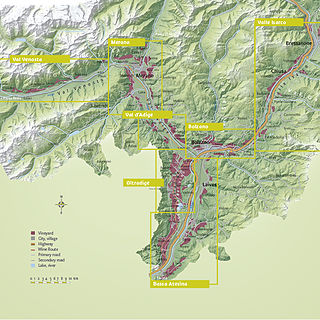
South Tyrol is an autonomous province located in northeast Italy producing wine. This Austro-Italian wine region is noted for the distinct Austrian influences on the wine industry, due to the region's long history under the rule of Austria-Hungary and Holy Roman Empires.

Gerhard Eichelmann is a leading German wine critic with an international influence on German wine.
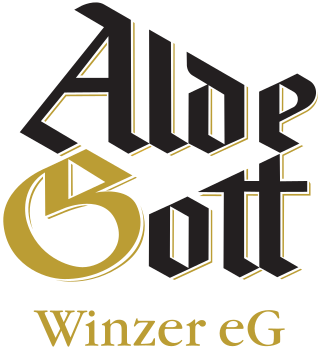
The Alde Gott Winzer eG was founded in Sasbachwalden (Germany) in 1948 and is part of the wine-growing region Baden. Today, there are 380 producers who cultivate 263 hectare of vines. Günter Lehmann runs the Alde Gott Winery eG as the general manager while cellarer Michael Huber is responsible for the winemaking.
Vöslauer is an Austrian mineral water brand.